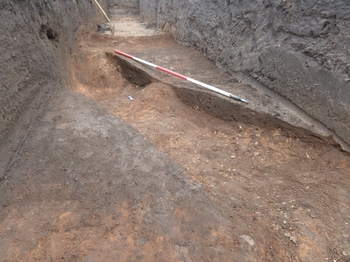Land West of Bridge Street, Wellesbourne, Warwickshire. Archaeological Evaluation (OASIS ID: cotswold2-209693)
Cotswold Archaeology, 2016. https://doi.org/10.5284/1039962. How to cite using this DOI
Data copyright © Cotswold Archaeology unless otherwise stated
This work is licensed under the ADS Terms of Use and Access.
Primary contact
Hazel
O'Neill
Cotswold Archaeology
Building 11
Kemble Enterprise Park
Cirencester
GL7 6BQ
UK
Tel: 01285 772624
Resource identifiers
- ADS Collection: 2389
- DOI:https://doi.org/10.5284/1039962
- How to cite using this DOI
Introduction

In January 2015, Cotswold Archaeology carried out an archaeological evaluation of land west of Bridge Street, Wellesbourne, Warwickshire. Seven trenches were excavated within the evaluation site.
The Warwickshire HER records limited evidence that a Saxon palace or other notable building stood in Wellesbourne, and the evaluation site had been suggested as the possible location of this putative building.
Three low linear earthworks run through the site and a level platform is present in the northwestern part of the site. One of the linear earthworks is in the location of a field boundary visible on a map of 1733, although it has been suggested that the earthworks at the site were created by army engineers during the Second World War. A geophysical survey of the site noted a number of anomalies of possible archaeological origin, some of which corresponded to the linear earthworks.
The evaluation recorded several shallow ditches, two wide ditches and a single probable pit at the site. There was a broad correspondence with the results of the geophysical survey. Artefactual material was almost absent, although one ditch contained two sherds of Roman pottery. The majority of the shallow ditches are likely to represent minor drainage or boundary features within an Iron Age/Roman agricultural field system. There was no evidence for any Saxon or medieval activity at the site.
The evaluation recorded an increased depth of topsoil and subsoil layers in the locations of the earthworks at the site. One linear earthwork was found to overlie at least two wide ditches, which were in the location of a field boundary depicted on the 1733 map. The remaining linear earthworks were located over ephemeral ditches. There were no archaeological deposits associated with the small level earthwork platform; as with the linear earthworks, it is probable that the platform is post-medieval or modern in date.





